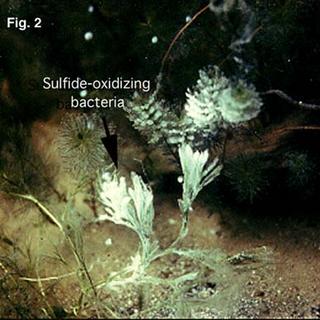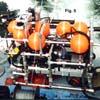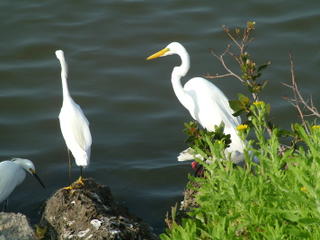4. South African landscape.
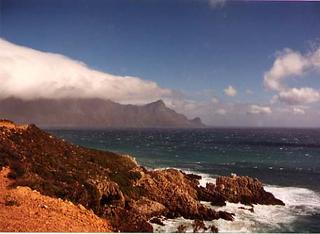 As we fly into Capetown, South Africa, over Robbins Island, where Nelson Mandela was held captive for forty years, you make contact with two major landscapes, Table Mountain , and to your right, the Cape of Good Hope jutting out into the South Atlantic. This is where the Dutch West Indies Trading Company set up their trading post in the early 1600's.
As we fly into Capetown, South Africa, over Robbins Island, where Nelson Mandela was held captive for forty years, you make contact with two major landscapes, Table Mountain , and to your right, the Cape of Good Hope jutting out into the South Atlantic. This is where the Dutch West Indies Trading Company set up their trading post in the early 1600's. At the tip of the Cape of Good Hope, is Cape Point. On the left is the Indian Ocean, and on the right, the southern Atlantic Ocean.
At the tip of the Cape of Good Hope, is Cape Point. On the left is the Indian Ocean, and on the right, the southern Atlantic Ocean.
Flying from Capetown to Johannesburg, or Jo'burg as they call it, we visited streets such as this with blooming Jacaranda trees. Quite a beautiful sight. You will notice that I have an attraction to trees.
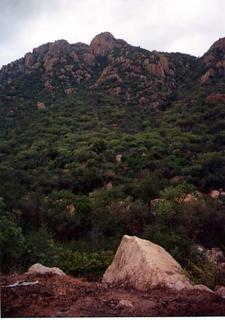 On our way to Kruger National Park, we crossed from the "low veldt" to the "high veldt" pictured here. This is not in the mountains, but is more analogous to the "high plains" of the US.
On our way to Kruger National Park, we crossed from the "low veldt" to the "high veldt" pictured here. This is not in the mountains, but is more analogous to the "high plains" of the US.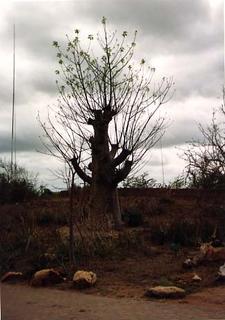
We finally reached the Kruger Park, and spent he first night at the Malelane Lodge, just outside the entrance, and this interesting Baobab tree.
 Inside the Park, on one of our daily excursions, we came across this candleabra tree. It was a change of scenery from the many acacia trees with their sharp thorns.
Inside the Park, on one of our daily excursions, we came across this candleabra tree. It was a change of scenery from the many acacia trees with their sharp thorns. While you are in the Park, you must stay in enclosed camps from about 6 o'clock in the evening until about 5 o'clock in the morning. The gates are locked, so that it is impossible to leave. This is a view taken at dusk near Oliphants, one of these camps. At night you hear hyenas running around the fence and hippos feeding down by the river.
While you are in the Park, you must stay in enclosed camps from about 6 o'clock in the evening until about 5 o'clock in the morning. The gates are locked, so that it is impossible to leave. This is a view taken at dusk near Oliphants, one of these camps. At night you hear hyenas running around the fence and hippos feeding down by the river. Another interesting tree found in the park is the Umbrella tree. These are often the refuge for many animals that gather beneath their branches during the heat of the day.
Another interesting tree found in the park is the Umbrella tree. These are often the refuge for many animals that gather beneath their branches during the heat of the day. Leaving Kruger Park, and heading south through Zululand, we came into the Drachenburg mountains. Spectacular landscapes greeted us, such as this showing the mountains and a high lake.
Leaving Kruger Park, and heading south through Zululand, we came into the Drachenburg mountains. Spectacular landscapes greeted us, such as this showing the mountains and a high lake. Moving inland from Durban and on our way to Rhodes University, we passed by this "hogsback" near King William Town.
Moving inland from Durban and on our way to Rhodes University, we passed by this "hogsback" near King William Town.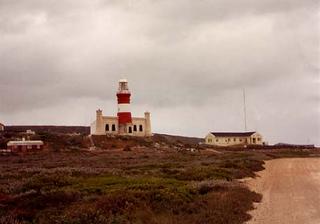 Heading back to the Indian Ocean, we traveled along the coast to the southern-most part of South Africa, Cape Agulas. This remote area in South Africa is at the very end of a large peninsula that is the "wheat belt" of the country, where much of the country's produce is grown.
Heading back to the Indian Ocean, we traveled along the coast to the southern-most part of South Africa, Cape Agulas. This remote area in South Africa is at the very end of a large peninsula that is the "wheat belt" of the country, where much of the country's produce is grown.













